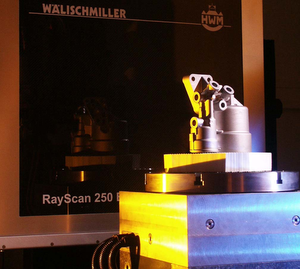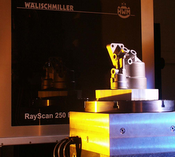Information
- Publication Type: PhD-Thesis
- Workgroup(s)/Project(s):
- Date: December 2009
- Date (Start): July 2005
- Date (End): January 2009
- TU Wien Library:
- Second Supervisor: Milos Sramek
- Rigorosum: 20. January 2009
- First Supervisor: Eduard Gröller
Abstract
Industrial X-Ray 3D computed tomography (3DCT) is on the edge of advancing from a non destructive testing method to a fully standardized means of dimensional measurement for every day industrial use. Currently 3DCT has drawn attention especially in the area of first part inspections of new components, mainly in order to overcome limitations and drawbacks of common methods. Yet an increasing number of companies is benefitting from industrial 3DCT and sporadically the first pioneers start using industrial 3DCT for quality control in the production phase of a component. As 3DCT is still a very young technology of industrial quality control, this method also faces severe problems, which seriously affect measurement results. Some of the major drawbacks for quality control are the following: Artefacts modify the spatial greyvalues, generating artificial structures in the datasets, which do not correspond to reality. Discrete sampling introduces further irregularities due to the Nyquist- Shannon sampling theorem. Uncertainty information is missing when extracting dimensional measurement features. Specifications and limitations of the components and the special setup a 3DCT constrain the best achievable measurement precision. This thesis contributes to the state of the art by algorithmic evaluation of typical industrial tasks in the area of dimensional measurement using 3DCT. The main focus lies in the development and implementation of novel pipelines for everyday industrial use including comparisons to common methods. Convenient and easy to understand means of visualization are evaluated and used to provide insight into the generated results. In particular three pipelines are introduced, which cover some of the major aspects concerning metrology using industrial 3DCT. The considered aspects are robust surface extraction, artefact reduction via dual energy CT, local surface extraction of multi-material components, and statistical analysis of multi-material components. The generated results of each pipeline are demonstrated and verified using test specimens as well as real world components.Additional Files and Images
Weblinks
No further information available.BibTeX
@phdthesis{heinzl-2008-thesis,
title = "Analysis and Visualization of Industrial CT Data",
author = "Christoph Heinzl",
year = "2009",
abstract = "Industrial X-Ray 3D computed tomography (3DCT) is on the
edge of advancing from a non destructive testing method to a
fully standardized means of dimensional measurement for
every day industrial use. Currently 3DCT has drawn attention
especially in the area of first part inspections of new
components, mainly in order to overcome limitations and
drawbacks of common methods. Yet an increasing number of
companies is benefitting from industrial 3DCT and
sporadically the first pioneers start using industrial 3DCT
for quality control in the production phase of a component.
As 3DCT is still a very young technology of industrial
quality control, this method also faces severe problems,
which seriously affect measurement results. Some of the
major drawbacks for quality control are the following:
Artefacts modify the spatial greyvalues, generating
artificial structures in the datasets, which do not
correspond to reality. Discrete sampling introduces further
irregularities due to the Nyquist- Shannon sampling theorem.
Uncertainty information is missing when extracting
dimensional measurement features. Specifications and
limitations of the components and the special setup a 3DCT
constrain the best achievable measurement precision. This
thesis contributes to the state of the art by algorithmic
evaluation of typical industrial tasks in the area of
dimensional measurement using 3DCT. The main focus lies in
the development and implementation of novel pipelines for
everyday industrial use including comparisons to common
methods. Convenient and easy to understand means of
visualization are evaluated and used to provide insight into
the generated results. In particular three pipelines are
introduced, which cover some of the major aspects concerning
metrology using industrial 3DCT. The considered aspects are
robust surface extraction, artefact reduction via dual
energy CT, local surface extraction of multi-material
components, and statistical analysis of multi-material
components. The generated results of each pipeline are
demonstrated and verified using test specimens as well as
real world components.",
month = dec,
address = "Favoritenstrasse 9-11/E193-02, A-1040 Vienna, Austria",
school = "Institute of Computer Graphics and Algorithms, Vienna
University of Technology ",
URL = "https://www.cg.tuwien.ac.at/research/publications/2009/heinzl-2008-thesis/",
}


 image
image paper
paper
